|
September 10, 2020
I hope that you and your loved ones are doing well, staying healthy, and looking out for your neighbors and friends in these incredibly difficult times.
Most of today’s newsletter will again be about the wildfires, but you’ll also find extensive COVID-related information, including the just-released OHA COVID Weekly Report.
Again, please let me know if you have any questions about any of the information in this newsletter.
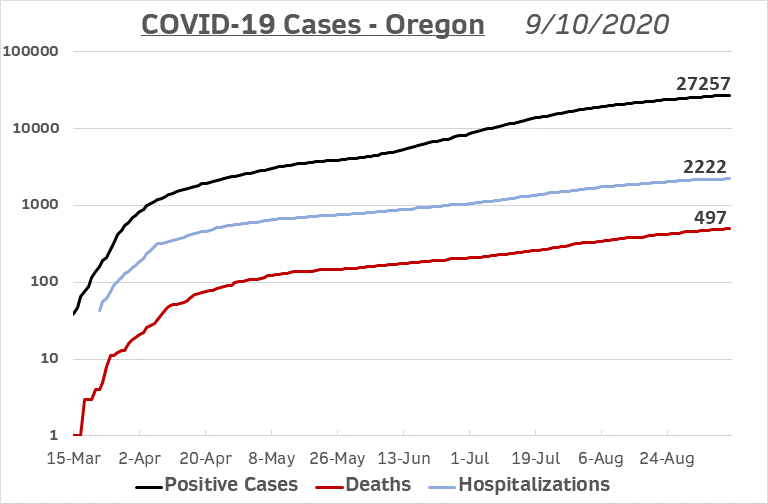
TODAY’S CORONAVIRUS AND CORONAVIRUS RESPONSE UPDATE
-
Positive Cases: OHA reports that 163 additional Oregonians have tested positive for COVID. The cumulative total of those testing positive since the beginning of the pandemic is now 27,257.
-
Total Tests: The number of reported tests has increased by 2,891. The cumulative total is now 595,591.
-
Ratio: The percentage of positive test result over the last four days in Oregon is 5.6%. The national ratio today is 6.1%.
-
Deaths: I’m sorry to report 3 additional deaths due to the coronavirus today. You can read more about the Oregonians we lost further down in the newsletter. The total number of COVID deaths in Oregon is now at 497.
-
Hospitalized: OHA reports 7 new COVID hospitalizations today. The cumulative number of those who have been hospitalized with COVID is now 2,222.
-
Presumptive Cases: OHA is including “presumptive COVID-19 cases” in its daily reports, consistent with recently amended guidance from the Centers for Disease Control and Prevention. A presumptive case is someone who does not yet have a positive PCR test but is showing symptoms and has had close contact with a confirmed case. If they later test positive by PCR, those will be recategorized as confirmed cases. The number of new presumed positives today is 19. The total number of presumed positives is currently 1,397.
-
Other Hospital Information:
- Patients Currently w COVID-19 Symptoms (who may or may not have received a positive test result yet): 162 (15 more than yesterday). Of those, 103 have already received a positive test back.
- Available ICU Beds: 154 (9 more than yesterday)
- Other Available Beds: 618 (47 fewer than yesterday).
- ICU Patients w COVID-19 Symptoms: 40 (9 more than yesterday).
- COVID-19 Patients Currently on Ventilators: 20 (2 more than yesterday).
- Available Ventilators: 787 (9 more than yesterday).
-
Dashboards
-
Today’s National Numbers:
- Total Tests: 84,556,561 (614,042 up from yesterday).
- Positive Tests: 6,329,405 6,366,986 (up 37,581 from yesterday.)
- Deaths: 182,779 183,949 (up 1,170 from yesterday).
- These national numbers come from the COVID Tracking Project. You can follow their updated numbers for each state and the nation as a whole here.
-
Additional Brief Updates:
- Again, for information about fires, firefighting response, smoke levels and much more, you can find a variety of Wildfire-related Resources here.
- I mentioned on Tuesday that the Department of Corrections was forced to evacuate adults in custody at three Salem-area state prisons to cramped emergency shelter at Oregon State Penitentiary in response to the Santiam Fire. I’m pleased to report that they were able to be returned to their home institutions (Mill Creek and Santiam Correctional Institutions) today. Those from the Oregon State Correctional Institution (OSCI) remain at OSP for now. We’re hoping that OSCI will be declared safe to return to tomorrow.
- On the other hand, the women and men at Coffee Creek Correctional Institution in Clackamas County had to be moved today once the fires in those areas had consolidated. The risk was too great to leave them there. Some have been moved to central Oregon and others (those currently in COVID quarantine) to the Oregon State Prison. Here’s a press release about that from the Department of Corrections.
Wildfire Update – Another Mixed, Very Tough Day
The extraordinarily dangerous weather conditions that I reported on yesterday started to shift this afternoon, which has led to mixed results around the state.
In another press conference held this afternoon, the Governor, the Department of Forestry’s Fire Chief (Doug Grafe), and the State Fire Marshal Deputy Director (Mariana Ruiz-Temple) provided an update on firefighting and evacuations in the various fires around the state. Elected leaders then received a briefing at the end of the day that provided further news and potential information for constituents.
We learned that this afternoon the winds did indeed begin to shift from east to west, which is great news in that for much of the state dry winds from the east will gradually be replaced by moister marine winds from the west. By Monday there may even be rain in parts of the state. That’s unfortunately less true in the southern parts of the state. Also, for now, it’s not true for the Columbia River Gorge, and that’s hurting conditions in Clackamas County and northern Marion County to the southeast of Portland.
Here are a few of the highlights from the press conference and the briefing:
- Firefighters are at last able to set up defensive lines (“anchor points”) in many of the wildfire areas, in order to slowly begin the process of moving from defense to offense.
- The area that’s currently the biggest challenge is in Clackamas County, where the fires that began yesterday around Estacada have now combined with the fires in Marion County and are creating their own weather system.
- This new evacuation zone to the southeast of Portland is home to 405,000 residents, and 26,000 of them have been told to evacuate immediately.
- On the positive side, a lot of progress has been made on the Coast, unfortunately not until more than 100 homes had been destroyed. Statewide, nearly a thousand homes appear to have been lost so far.
- We still have no idea of the extent of human loss. But those with experience are preparing us for tragic results when they are finally able to get into the areas where the fires exploded suddenly and without warning.
- Our ten-year average for acres burned is 500,000 acres burned per year. In the last few days we have experience more than a million acres lost to wildfire.
- The Governor has not yet heard back from the President on her request that Oregon be declared a catastrophic disaster area, which triggers a number of supports from FEMA. But we did learn that FEMA is stepping up and helping even before that official declaration has been received.
- We have already received help from a number of other states, including Nevada and Utah.
We again heard stories of true heroism on the part of firefighters and first responders all over the state, for which we must all be grateful. We’ve also heard stories of incredible escapes and homes unexpectedly and miraculously spared from destruction. I mentioned yesterday that a senator had his home completely destroyed. We thought that the same had happened to another legislator on the coast—and then learned that the fire had stopped just yards away from his home.
Some Advice to Pass On
Legislators have again received the following additional requests to pass on.
- Everyone should find out what the fire status for their area is. Check on your county’s web site. If you haven’t yet signed up for Reverse 911 notifications, do so.
- Please don’t call 911 unless it’s a true emergency.
- If you’re in or close to an evacuation zone, be prepared. Sudden shifts in wind can put you suddenly at risk. If you’re in a Zone 2 area, you should definitely have a plan for where you’re going and what you will take.
- Stay close to home if you can. Certainly, stay far away from the evacuation areas. We were clearly told today that that applies to legislators as well!
- Know that in many cases, reunification is going to be a challenge. The Red Cross will be coordinating reunifications, so it’s important that evacuees register with their “Safe and Well Registry.”
- If you’re looking for a loved one, check with the Red Cross first, rather than the police.
- Consider donating to the Red Cross or any of the other organizations that will be stepping up to provide food, support, and shelter to those affected by these tragic conditions. They’re going to need our support.
What If You’re Quarantining from COVID and You Receive an Evacuation Order?
We just received the following guidance from OHA:
During Oregon’s wildfires and safety evacuations, it is important to take precautions to avoid spreading COVID-19, particularly for those in isolation or quarantine due to a positive diagnosis or exposure to the virus.
The first priority in wildfire situations is responding to the evacuation and safety instructions of local and state fire officials – and heeding their warnings. Regardless of disease status, if you are asked or ordered to evacuate, you should do so.
If you or a household member are quarantining or isolating to prevent the spread of COVID-19, please take the following precautions:
- If ordered to evacuate, do so immediately. Follow all instructions from fire officials.
- If you have time, reach out to your local public health authority, who should have already been in contact with you about your isolation/quarantine. They may have solutions to help you continue to isolate/quarantine if you are evacuated.
- Should you be directed to a shelter or other evacuation space, please let officials know you are in isolation/quarantine so that they can take steps to keep you distanced from other evacuees.
- Wear a mask at all times when outside your home, or if you may come into contact with people who do not live with you.
-
If you are an older adult or a person with disabilities, reach out to the Aging and Disabilities Resource Connection for information about resources 1-855-ORE-ADRC(1-855-673-2372).
- Practice physical distancing to the greatest extent possible, if you must travel outside your home for any reason, including evacuation.
-
More information about wildfire safety and your health is available on org/wildfires.
- Additional resources can be found by calling 2-1-1.
-
Find statewide Oregon Wildfire Resources at oregon.gov/
Latest OHA Weekly COVID Report Released
OHA released its WEEKLY COVID REPORT today. It is again a very comprehensive snapshot of different aspects of transmission of the disease in Oregon over the past week or so. It confirms what we’ve been seeing in our daily reports: an ongoing reduction of transmission in Oregon, with declines in new infections, declining positivity, declining testing, declining hospitalizations, and declining deaths. However, it also shows ongoing disproportionality among racial and ethnic groups.
Here are some of OHA’s broad observations of where we are now, based on data from August 31 to September 6:
- We are continuing to see a decline in the number of new cases. Last week OHA recorded 1,477 new cases of COVID-19 infection—down 5% from the previous week’s tally of 1,558. This is the lowest number of new infections that we’ve seen since the end of June, and it marks the 5th consecutive week of declining case counts.
- The statewide infection rate is now 665 cases per 100,000 Oregonians.
- The percentage of positive test results is continuing to decline. Last week’s positivity rate was 4.3%, the lowest it’s been since June.
- Since death rate is a “lagging indicator,” it has taken time to see declines in death rates that corresponded with the decline in cases. Fortunately, we are now starting to see those declines. Twenty-three Oregonians were reported to have died last week, compared to 39 the previous week.
- The cumulative death rate since the beginning of the pandemic is 4 deaths per 100,000 Oregonians, with a cumulative total of 482 on September 5. This is a mortality rate of 1.7% of reported cases.
- As I’ve reported before, our testing is not what it should be. Last week 26,855 tests were reported. That number will go up as more results come in for last week, but even when those numbers are added, it will be clear that we continue to test well below our capacity. In the days after the cutoff date for this report, the testing numbers have declined further.
- The age group with the highest incidence of reported infection continues to be 20–29-year-olds, with rates decreasing in subsequent decades of life.
- Black Oregonians are still less likely to be interviewed as part of contact tracing than are White Oregonians; Latinx Oregonians are more likely to be interviewed than are other Oregonians.
The report again provides information about signs, symptoms, and risk factors; racial/ethnic/age/gender demographics; recovery; outbreaks in long-term care; workplace outbreaks; hospital rates; and the breakdown of cases by zip code.
Racial/Ethnic
The report again demonstrates significant disparities among racial groups. You can see this in the charts below, with data that I’ve taken from the August 26 report, the September 2 report, and from this report. It allows you to see at a glance the proportion of case counts within different racial groups and ethnic groups (technically, “Hispanic” is not a race and is counted as an ethnic group, with numbers from a separate chart). They remain relatively stable.
You’ll see again how much higher the rates per 100,000 are for most racial/ethnic groups compared to White Oregonians. Black Oregonians are nearly four times more likely to contract the disease than are White Oregonians, Native Americans more than five times more likely, Latinx Oregonians are 6.6 times more likely, and Pacific Islanders are now a little over ten times more likely (a disparity that has actually reduced somewhat).
You’ll also again see that the percentages of those hospitalized from the disease are somewhat lower for Blacks, Latinx, and Native Americans, and somewhat higher for than for the population of White Oregonians (the exceptions are Pacific Islanders and Asians, which is higher, and the Hispanic, which is much lower). Whites in Oregon are generally much more likely to die from the disease than are Non-Whites.
 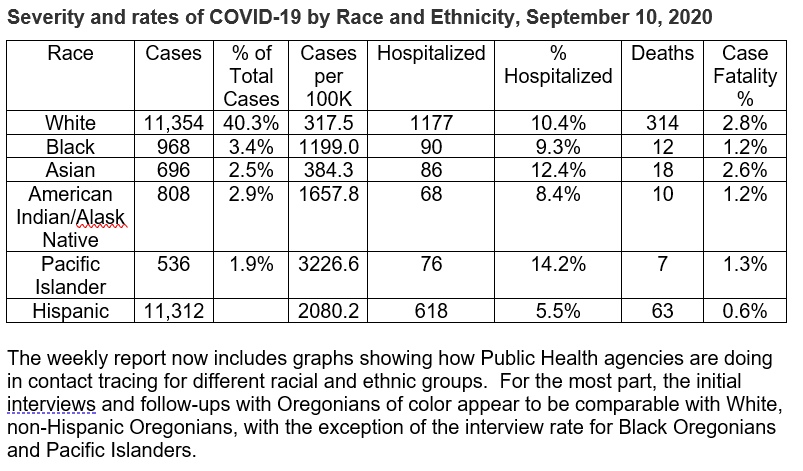
Outbreaks at Long-Term Care Facilities
The report lists outbreaks at long-term care facilities with more than five residents that have three or more confirmed cases or at least one COVID death. Fortunately, we are seeing a continued reduction in active outbreaks in these facilities.
This week’s report lists outbreaks in 46 (up from 45) long-term care facilities that are still considered active. They are responsible for 652 cases (down from 748) and 65 deaths (down from 74).
In addition, there are 43 outbreaks considered resolved (down from 88). They are responsible for 614 cases (down from 1,365) and 61 deaths (down from 181). To be listed as a “resolved” outbreak, a facility must not have had a new case in at least 28 days.
The total for active and resolved facilities is thus 1,266 cases (down from 2,113 last week) and 126 deaths (down from 255 last week) for the 89 facilities (down from 133).
I believe that facilities that have been in “resolved” status for a while are now being dropped from that list, hence the above reductions. I’m checking on that.
In addition to the listed facilities, there are 32 (four more than last week) congregate settings with five or fewer beds that have also had three or more confirmed cases or one or more deaths, so the above totals are actually somewhat higher.
To date, there has still been only one death of a staff member reported.
Workplace Outbreaks
Similarly, there are separate listings for workplace outbreaks that are “active” and “resolved,” but without deaths identified by workplace. Case counts include all persons linked to the outbreak, which may include household members and other close contacts. To protect privacy, OHA is only reporting workplace outbreaks with five or more cases and only for workplaces with at least 30 workers.
So far, eight deaths have been the result of workplace outbreaks, a figure fortunately unchanged for more than two months.
You’ll find 74 workplaces (up from 73 last week) listed as “Active” this week, totaling 2,253 (up from 2138, last week).
58 workplaces (down from 114) are listed as “Resolved,” totaling 1,073 cases (down from 1,770 last week).
The total number of cases for both is thus 3,908 (down from 3,908 last week).
Those listed include workplaces with at least 5 cases identified among workers or family members. They are listed in descending order of number of cases.
The top two workplace outbreaks in Oregon today are again in Eastern Oregon state prisons, and another Eastern Oregon prison is not far behind. I will add that I don’t believe that the 8 deaths attributed to workplace outbreaks include the deaths of adults in custody. There have now been six.
Childcare Outbreaks
The Weekly Report again includes names and case counts for childcare facilities that enroll 30 or more children and have five or more cases. The one that had previously been listed as active (Trout Creek Bible Camp in Corbett), has been moved to resolved status. It was replaced by Little Village Learning Center in Salem, which reports five cases.
Without listing them by name, the Weekly Report also includes the total number of smaller facilities (i.e., enrolling fewer than 30 children) that have had five or more cases. OHA reports that there have now been five such facilities
Infections by Zip Code
You’ll see that the zip code list again reveals the various hot spots around the state, presented in terms of cases per 10K residents. They are roughly the same (from Umatilla/Morrow, Jefferson, and Malheur Counties) as they’ve been for the last few weeks:
- 97818 (Boardman in Morrow County)
- 97761 (Warm Springs in Jefferson County)
- 97838 (Hermiston in Umatilla and Morrow Counties)
- 97882 (Umatilla in Umatilla County)
- 97914 (Ontario in Malheur County)
97875 (Stanfield in Umatilla County) remains on deck at #6.
Here is a zip code locator for you to use as you look at the zip code numbers.
Where Are Today’s New Cases?
If we put together the positive test results and new “presumptive” cases reported today, the overall number of new cases is 187. Of these, just under 2/3 are from outside the Portland Tri-County area, with Marion County again having the highest case count. Here is the breakdown by county for today:
Benton (4)
Clackamas (12)
Clatsop (3)
Columbia (1)
Coos (3)
Deschutes (2)
Hood River (1)
Jackson (8)
Jefferson (3)
Josephine (1)
Klamath (2)
Lane (5)
Lincoln (1)
Linn (6)
Malheur (16)
Marion (35)
Morrow (1)
Multnomah (33)
Polk (4)
Umatilla (6)
Union (3)
Wasco (1)
Washington (27)
Yamhill (9)
And the Deaths
Oregon’s 495th COVID-19 death is an 82-year-old man in Lane County who tested positive on Aug. 27 and died on Sept. 9, in his residence.
Oregon’s 496th COVID-19 death is a 56-year-old man in Malheur County who tested positive on July 31 and died on Sept. 9, at St. Alphonsus Medical Center Nampa in Idaho.
Oregon’s 497th COVID-19 death is an 81-year-old woman in Multnomah County who tested positive on Aug. 28 and died on Sept. 8, in her residence.
Additional Graphs:
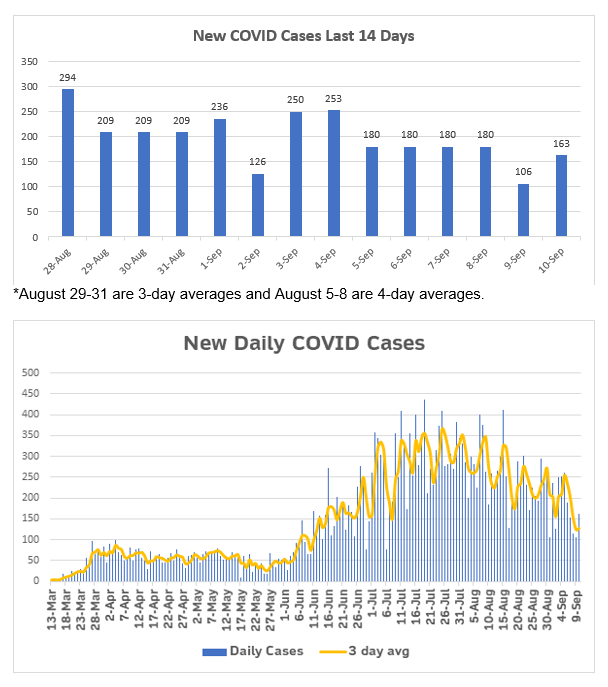   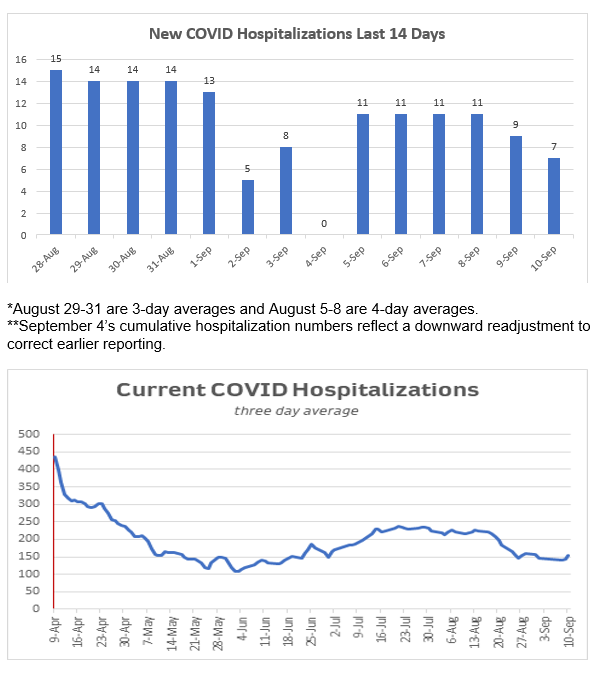 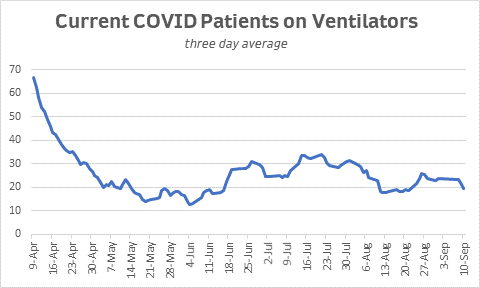
Want to See Past Newsletters?
If there was COVID-related information in a past newsletter that you want to go back to, but find you’ve deleted it, you can always go to my legislative website (senatordembrow.com), click on “News and Information,” and you’ll find them all there. Also, if someone forwarded you this newsletter and you’d like to get it directly, you can sign up for it there.
AND FINALLY,
Here again are some resources that you will find useful:
If the above links are not providing you with answers to your questions or directing you to the help that you need, please consider me and my office to be a resource. We’ll do our best to assist you or steer you in the right direction.
Best,
 Senator Michael Dembrow
District 23
email: Sen.MichaelDembrow@oregonlegislature.gov
web: www.senatordembrow.com
phone: 503-986-1723
mail: 900 Court St NE, S-407, Salem, OR, 97301
|